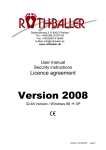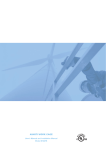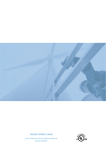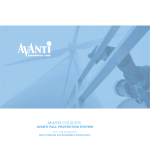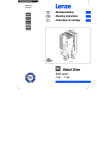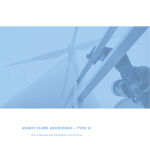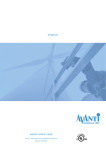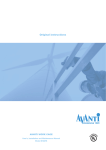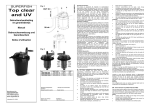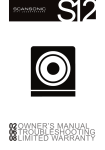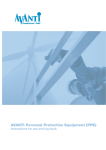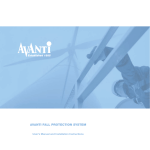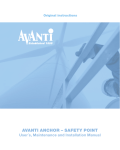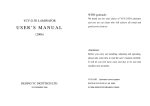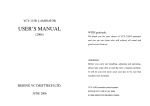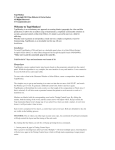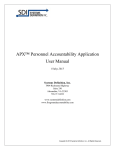Download Untitled - Avanti Online
Transcript
AVANTI Climb Assistance – Type VI User’s Manual and Installation Instructions AVANTI Aufstiegshilfe – Typ VI Benutzerhandbuch und Montageanleitung 2nd Edition: December 2006 2. Ausgabe: Dezember 2006 Manufacturer/ Hersteller: AVANTI Stigefabrik A/S Høgevej 19 3400 Hillerød · Denmark P: +45 4824 9024 F: +45 4824 9124 E: [email protected] I: www.avanti-online.com Sales & Services: Vertrieb und Dienstleistungen: USA Avanti Wind Systems, Inc. 5145 South Emmer Drive New Berlin Wisconsin 53151 USA P: +1 (262) 641-9101 F: +1 (262) 641-9161 I: www.avanti-online.com SPAIN/ SPANIEN Avanti Wind Systems SL Poligono Industrial Centrovia Calle Los Angeles No 15 nave 10 50196 La Muela Spain/ Spanien P: +34 976 149524 F: +34 976 149508 I: www.avanti-online.com CHINA Avanti Wind Systems Thousand Ocean Ltd. Shanghai Rep. Office 266 Xikang Rd. Office 200040 Shanghai China P: +86 21 6279 4119 F: +86 21 6279 4534 I: www.avanti-online.com 26 27 System outline Introduction Fig. 1 Caution: • An AVANTI Fall Protection Technician is a person that has participated in and passed the AVANTI Fall Protection Technician Course and is considered an expert. • A competent person is a person that has fully read and understood these Climbing Assistance User’s Manual and Installation Instructions. • The AVANTI Climbing Assistance installation and service may only be carried through by a competent person or an expert. • Once a competent person or an expert installs, services, or in any other way alters the Climbing Assistance system, he alone is responsible for doing so in accordance with these User’s Manual and Installation Instructions. 1 10 9 5 12 2 4 6 3 13 7 8 28 11 3 19 14 15 17 18 21 List of Signs: 1. 2. 3. 4. 5. 6. 7. 8. 9. 10. 11. Wall Ladder Ladder brackets Steps Platform Resting platform Person ascending Harness Upper end Top fitting with wheel Hauling rope 12. 13. 14. 15. 16. 17. 18. 19. 20. 21. Guide roller Guide roller Lower end Motor Driving wheel Power supply Spring loaded base Electrical control box Wheel guard Sensor with cable Danger: • Do not keep or store the hauling rope in direct sunlight. • Keep the hauling rope clean and free of oil, grease and chemicals. • Only install an earth leakage circuit breaker that react to pulsing DC. Installation Manual Fig. 2 Motor AVANTI recommend the following installation procedure. 1. Install the motor underneath the ladder. 2. Install hauling rope and guide rollers. 1. Motor installation: Fig. 3 Motor positionering 1. Position motor base with motor and rope wheel at the centre of the ladder (see fig. 2). In case a fall protection rail is positioned at the ladder centre, align the motor base as shown in fig. 3. This will leave the hauling rope approximately 20 mm off the fall protection rail to the right side (fig 3). Once the motor is aligned fasten it to the tower platform using 4 pcs. Ø8mm bolts. Start with the bolt closest to the ladder centre (the bolt closest to the fall protection rail). If possible it may be an advantage placing the motor in the basement underneath the bottom platform. In that case use wall anchor for mounting. 2. Position the electrical control box in the vicinity of the ladder. Mount electrical control box to the platform using the angle fittings (see fig. 4). 20 mm 10-80 mm 110-180 mm 27 29 Fig. 4 Electrical control box Pulling force adjustment On / Off 2. Electrical cable installation 2.1 Sensor installation The electric cables are marked. Connect the cables to the rack inside the electrical control box as follows below or alternatively see Circuit diagram in appendix B. Feed the sensor cable through the middle connection underneath the electrical control box (see Appendix A). Fig. 5 Electrical control box open 30 Fig. 6 Sensor and sensor cable Connect the pulse sensor cable to the electrical control box as follows: - Black wire to E 1 - Brown wire to 20 or 28 - Blue wire to 7 (the 7 that is not in use) Adjust sensor leaving a distance of 0,5-1,5 mm between driving wheel and sensor. ONLY ADJUST SENSOR WHILE THE SYSTEM IS UNPLUGGED. After mounting hauling rope, the sensor may need adjustment. 2.2 Sensor test After installing the hauling rope turn on the power and the green diode on the sensor will light. Pull rope – the sensor should register the movement and respond by indication in white and start the motor. – If not, adjust the sensor focus on the driving wheel according to the Sensor installation. 2.3 Motor cable installation Connect motor cable W1 3, 3-phase to motor as follows: - Conductor 1 to U - Conductor 2 to V - Conductor 3 to W - Green-yellow conductor to earth connection - Conductor 4 and 5 – connect to the terminal. 4 and 5 connects to a thermal switch - hence the order of connection is of no importance. - Conductor 6 is not used 3. Rope mounting 1. Bring the top fitting including block, bolts, and the one end of the hauling rope to the ladder top. It is often easier to bring up the rope on the front side and down on the rear side. Fig. 8 Fig. 7 Motor 31 2.4 Power cable installation Once the climbing assistant is fully installed connect power cable to 230 V, 50-60 Hz (1 phase + 0 + earth) power outlet. If additional power cable is attached use a 3x1,5mm2 for phase 0 and earth cable. Secure power supply with a 10 amp fuse. Use a HPFIrelay with 300mA fault current fuse. 2. On top of the ladder, mount the top fitting as shown in fig. 8. Using the holes in the top fitting, the block is positioned just off the rail centre so it marches the bottom pulling wheel position. The top fitting and block shall be mounted so potential injury to fingers etc. is eliminated. If this is not possible a guard is needed. 3. Pull the rope through the block and bring down the rope on the other side of the ladder while descending. 4. Down at the base platform feed the rope down through the pulling wheel. Tighten rope slightly and fasten – do not splice yet. 5. On the non climbing side of the ladder mount the hauling rope guiders. The guiders function is to prevent the rope from dragging on the ladder, platforms etc (fig. 9-10). Use a guide roller at every tower platform and at every ladder resting platform. Some ladder resting platforms may need a long version of the guide roller (see fig 9). Fig. 9 Guide roller 7. After having mounted all rollers and motor loosen the tensioning spring (fig. 16 page 16) and open the motor base plate as much as possible. Tighten the rope with kg. 75. Use separate rope or rope tensioner as shown in fig. 15 below. Leave rope for 20 min. and recheck tension. The rope has most likely stretched – tighten again. Repeat until the rope does not stretch any more. Fig. 12 Rope tensioning a) Rope tensioning b) Fig. 10 Guide roller mounted 32 6. On the climbing side of the 1st or 2nd step mount a guarded version of the guide roller. (see fig. 11). Fig. 11 Guarded guide roller 8. Cut of the excess rope leaving an overlap of 50 cm. These 50 is needed for the splicing. 9. Splice rope as described in section 3 below. 10. Finally tighten the spring on the motor base to a length of 60 mm. After mounting hauling rope, test the sensor as described in section 2.2. 3. Rope mounting 3.1 Splicing of hauling rope Insert splicing needle (black rope) into red rope minimum 250 mm from red rope-end. Fig. 13.3 For the rope splicing use the supplied splicing needle. First assure the rope is stretched satisfactory. For clarifying the splicing process one rope marked with red tape and the other with black. Seale one rope with red tape. On the same ropeend place a red tape mark minimum 250 mm from rope end. Feed the splicing needle through red rope – in the full length of the needle. Fig. 13.4 Push The other rope-end is likewise sealed and marked with black tape. Push 33 Fig. 13.1 min 250 mm Feed splicing needle out through the side of the read rope. Insert black rope-end into splicing needle Ø10mm. Make sure the rope end is firmly placed inside the needle and lies in the needle sloth. Fig. 13.2 a Fig. 13.2 b Fig. 13.5 Remove splicing needle. Pull black rope through red rope until the black mark has just passed the read mark. This way black rope end gets pulled back into red rope. The black mark should just be visible. Fig. 13.8 Fig. 13.6 Red rope is now locked round the black rope – now change directions and feed red rope end into black rope like follows: With your right hand hold red and black rope mark fixed. Insert splicing needle into black rope as close to the black rope mark as possible. Fig. 13.7 a 34 4 Fig. 13.9 Hold Pull Uses your left hand for sliding red rope over black rope. Fasten red rope-end in splicing needle. Fig. 13.7 b Fig. 13.10 3. Rope mounting 3.1 Splicing of hauling rope Insert splicing needle (black rope) into red rope minimum 250 mm from red rope-end. Fig. 13.3 For the rope splicing use the supplied splicing needle. First assure the rope is stretched satisfactory. For clarifying the splicing process one rope marked with red tape and the other with black. Seale one rope with red tape. On the same ropeend place a red tape mark minimum 250 mm from rope end. Feed the splicing needle through red rope – in the full length of the needle. Fig. 13.4 Push The other rope-end is likewise sealed and marked with black tape. Push 35 Fig. 13.1 min 250 mm Feed splicing needle out through the side of the read rope. Insert black rope-end into splicing needle Ø10mm. Make sure the rope end is firmly placed inside the needle and lies in the needle sloth. Fig. 13.2 a Fig. 13.2 b Fig. 13.5 4. Dismantling 6. Technical specifications Remove rope followed by rollers, top wheel, motor, and electrical control box. Dispose of according to local authorities. Electricity connection: 230 V, 50-60 Hz AC with earth (1 phase + 0 + earth) Fuse: 10 – 16 A Power consumption max.: 9A Power consumption at full load: approx. 7.2 A Adjustable lifting capacity approx.: 35 - 45 kg 5. Marking Fig. 14 Product marking Adjustable Speed: 0 +/- ca. 14 m/min preset Operational temperature: -10°C – +55oC Weight - Driving unit: approx. 23 kg Electricity case: approx. 12 kg Hauling rope Ø8,8mm: approx. 68 g/m Fig. 15 Quick guide 36 45541072 Quickguide climb EN/DE Gear oil: 0.7 l in the gearbox, e.g. CLP460 Mobil CLP460 AGIP OMALA460 Shell or similar. Filled up with oil at delivery. User’s Manual 7. Purpose Caution: • An AVANTI Fall Protection Technician is a person that has participated in and passed the AVANTI Fall Protection Technician Course and is considered an expert. • A competent person is a person that has fully read and understood these Climbing Assistance User’s Manual and Installation Instructions. • The AVANTI Climbing Assistance installation and service may only be carried through by a competent person or an expert. • Once a competent person or an expert installs, services, or in any other way alters the Climbing Assistance system, he alone is responsible for doing so in accordance with these User’s Manual and Installation Instructions. Danger: • Do not store the hauling rope in direct sunlight. • Keep the hauling rope clean and free of oil, grease and chemicals. • The power supply must not be equipped with an earth leakage circuit breaker that does not also react to pulsing DC as this will cause operational problems. Not intended for • Not intended for lifting tools or parts. • Not intended for people below the age of 18 or people below the weight of 55 kg. • Not intended for multiple users at the same time. • Not to be fastened to body parts or cloth. The Climbing Assistant is not a fall protection device. Always wear proper fall protection equipment (P.P.E.) Use original parts – no warranty is provided against damage resulting form reconstruction or modification of equipment or use of nonoriginal parts. Functionality The system includes a motor, a continuous hauling rope, an electrical control box and a rope clamp. Hook on to the hauling rope using the rope clamp and activate the motor by pulling the hauling rope. A sensor on the pulling wheel then registers the movement and starts the motor. The hauling rope then pulls with the pre-adjusted force (e.g. 30 kg.) no matter the pace and direction of climbing. Stopping the rope in the same position for 3 seconds, the same sensor register that motion has stopped, and the pulling force fades out. 8. Daily inspections Intended use The AVANTI Climbing Assistance is intended for personal ascending and descending of long durations on fixed ladders. a) Check rope tension spring on motor base (see fig 16). If spring length is more than 60 mm, the rope needs tensioning. Tension the spring with a spanner. If this does not tighten the rope sufficiently a rope shortening is needed. See Installation Instructions section 2.7. 37 b) Assure rope is aligned on the guiding rollers and on the pulling wheel (see fig. 17). The rope can be aligned on both right and left side. c) If anything abnormal is observed, take climbing assistance out of use. Correct error before continuing use. Fig. 16 Motor base plate with inductive sensor and tensioning spring 60 mm c) d) e) f) g) h) i) supply (230V-50/60 Hz) and/or turn on the red switch on the grey electrical control box. Adjust pull force (1 to 10) on grey electrical control box (fig. 18). Depending on rope length this equals approximately 35 - 45 kg. Connect harness and fall protection device (P.P.E) as prescribed by manufacturer. Fasten rope clamp carabiner on harness. Fasten rope clamp on climbing assistance rope (fig. 19). Pull climbing assistance rope to activate motor. STOP – stand still for 5 seconds. After use, turn off the power supply and unpluck from power outlet. Connect the rope clamp carabiner to the harness D-ring at waist or chest level for best comfort. 38 Fig. 17 Rope alignment. Rope can be aligned on both left and right side App. 14 mm WARNING! Keep hauling rope dry and free of oil and grease. When using the climbing assistance keep fingers and other body parts, clothes, etc. away from hauling rope, driving wheel, blocks, etc. NOTE! The main switch may not be connected/ disconnected several times in rapid succession. Doing so may damage the electrical installations. 9. Directions for use Fig. 18 Fig. 19 Rope clamp on rope Before use read and understand these user’s instructions. For use do as follows: a) Perform the daily inspection described above. b) Check if green light on motor wheel guard is on (see fig. 16). If not: connect to the power Pulling force adjustment On / Off 10. Maintenance 12. Trouble shooting The AVANTI Climbing Assistance is mainly maintenance free. Perform daily inspection as prescribed above and take action if abnormalities are found. • Before servicing the motor, motor base, wheel guard and double guarded rollers un-pluck the power supply and wait for at least 1 minute. • The hauling rope does not start when pulled: 1. Pull the hauling rope by hand. If the rope is stuck – find the blocking factor and fix it. 2. Check that the system has been plugged in. 3. Check that the system is switched on. 4. Check whether the green sensor diode on the wheel guard is lit - If not, check whether the electrical installation is done in accordance to the installation instructions. 5. Pull the hauling rope by hand. If the motor does not start after pulling the rope firmly check white sensor on motor guard. The white sensor indicates movement. If the white sensor does not indicate movement when rope is pulled adjust sensor as described in section 2.1 sensor installation. Yearly control: 1. Assure al bolts and nuts are fixed (on motor, electrical control box, rollers, and top fitting). 2. Assure that the compression spring is tightened to L = 60mm (see Daily inspections section 8 a). 3. Gear oil: - change gear oil every 3 years (see section 8. System specifications) (year of last oil replacement is entered in test report appendix C). 4. Remaining parts should be replaced once they show sign of being worn out (driving wheel, hauling rope, etc.). If only a part of the hauling rope needs replacement, insert a new section where it is worn. • Motor and motor wheel goes round, but the hauling rope does not follow: 1. Check whether the driving wheel is fixed on the gear shaft. 2. Check whether a rope clamp is stuck in the top block. 3. Check tension of hauling rope. Is the tensioning spring tightened to approximately 60 mm? – If not adjust rope as specified in section 8 a) Daily inspections. 4. Check rope and driving wheel for wear and tear. If the hauling rope and/or the driving wheel is worn down they loos grip. Have them replaced. 5. Check whether the guide rollers are blocked. 11. Yearly control Once a year a competent person or an expert must inspect the climbing assistance. If not – this will void the warranty. AVANTI runs “Fall Protection Expert classes” on regular basis. If interested contact AVANTI. • The tractive force too is small: 1. Check whether the motor electronics is connected in triangle – if not, connect in triangle. 39 Appendix A: Electrical control box overview 380 MM -A AE1380.600 lk SKAB 380 MM -U22 40 MM BOTTOM TORQUE ADJUSTMENT On PE PE PE PE 210 MM I -R16 Off O 80 MM 120 MM 40 75 MM 380 MM 60 MM ECM GUIDE -W13 -W11 -W17 PULSE SENSOR MAIN SUPPLY 135 MM M20 M16 MOTOR 135 MM M20 Appendix B: Circuits -U13 L1 L2/ L3 PE N +UG-UG K12 K13 K14 E82EV152 K2C INVERTER CLIMBING ASSISTANCE U V W PE. T1 T2 E82ZAFAC APPLICATION I/O JUMPER A+B ARE REMOVED FROM APPLIKATIONS I/O 1U 1I 2U 2I 62 63 9 A1 A2 7 7 A4 59 20 28 E1 E2 E3 E4 E5 E6 -U15 1 3 5 VCCF0 -Q11 2 4 6 3X0,5MM2 CY-OZ -W16 / / / BLACK MM BLUE BROWN -W17 SENSOR CABLE S 5 4 Y/G 3 2 1 -W13 CABLE 3,0 METER OUT OF CABINET S 1 3 2 7X1,5MM2 YCY-JZ MM1 PE PE / / / 1 2 PNP -B17 U V W PE t? 2 M 3 1 Y/G BLUE BROWN -W11 -M13 MA2AL90S-6/B14-C140 CABLE 5,5 METER OUT OF CABINET MOTOR CLIMBING ASSISTANCE -R16 V+ VSIG. Variable Resistor 10Kohm/1W TORQUE ADJUSTMENT 3 PULSE SENSOR 41





































